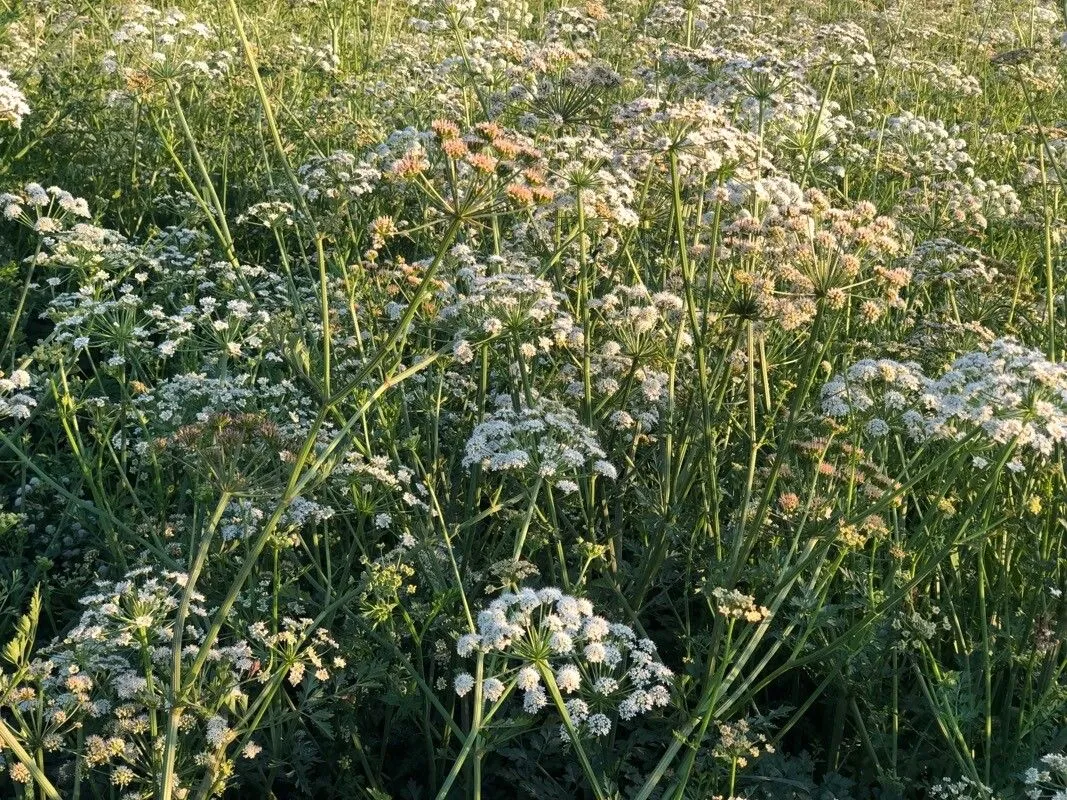
Author: L.
Bibliography: Sp. Pl.: 254 (1753)
Year: 1753
Status: accepted
Rank: species
Genus: Oenanthe
Vegetable: False
Observations: Madeira, W. Europe to W. & C. Medit.
Water-dropwort, scientifically named Oenanthe crocata, is a plant species belonging to the Apiaceae family. Originally described by the renowned botanist Carl Linnaeus in his seminal work “Species Plantarum” in 1753, this plant is noted for its distinctive appearance and ecological distribution.
This remarkable species is predominantly observed in regions spanning Madeira and Western Europe, extending to the Western and Central Mediterranean areas. This distribution highlights Water-dropwort’s adaptability to various climatic conditions in both lush, temperate zones and sunny Mediterranean climates.
Characterized by its umbrella-shaped clusters of small, white flowers, Water-dropwort presents a delicate and visually appealing form typical of many Apiaceae members. The plant thrives in wet environments, often found along stream banks, ditches, and other marshy locales where it can access abundant moisture.
Despite its alluring presence, it is crucial to approach Water-dropwort with caution. The plant contains potent toxins which can be harmful if ingested, and thus it remains a pertinent subject of interest in discussions of toxic flora within its native regions. Its toxic properties have warranted ongoing scientific scrutiny to better understand its impact on local ecosystems and potential risks to livestock and human health.
Understanding Water-dropwort is essential not only for botanical studies but also for environmental management and public health awareness in areas where it is prevalent. As such, Oenanthe crocata remains a significant specimen within botanical, ecological, and toxicological research spheres.
Dan: gift-klaseskærm
Eng: hemlock water-dropwort, water-dropwort, water-hemlock
Deu: safrangelber wasserfenchel, safranwasserfenchel
Nld: dodemansvingers
Swe: kronstäkra, saffransstäkra
Fra: oenanthe safrané
Cym: brelwg, ccgid crogedyf, cegid y dŵr, cegiden y dŵr, dibynlor cegidaidd, gyblys, gysplys, tafod angau
En: Water-dropwort, Water-hemlock, Hemlock water-dropwort, Dead Tongue, Horsebane
Da: Gift-klaseskærm
Nl: Dodemansvingers
Fr: Oenanthe safrané, Oenanthe safranée, Pansacre, Pimpin
De: Safrangelber Wasserfenchel, Safranwasserfenchel, Safran-Pferdesaat
It: Finocchio-acquatico con foglie di prezzemolo
Sv: Kronstäkra, Saffransstäkra
Cy: Brelwg, Ccgid Crogedyf, Cegid y Dŵr, Cegiden y Dŵr, Dibynlor Cegidaidd, Gyblys, Gysplys, Tafod Angau
Taken Jun 10, 2021 by Pierre LEON (cc-by-sa)
Taken May 8, 2022 by de Toro Cacharrón (cc-by-sa)
Taken Jun 10, 2021 by Pierre LEON (cc-by-sa)
Taken May 17, 2017 by Jose Luis Romero (cc-by-sa)
Taken May 28, 2019 by jan jan (cc-by-sa)
© copyright of the Board of Trustees of the Royal Botanic Gardens, Kew.
© copyright of the Board of Trustees of the Royal Botanic Gardens, Kew.
© copyright of the Board of Trustees of the Royal Botanic Gardens, Kew.
Taken May 4, 2012 by Tela Botanica − Emmanuel STRATMAINS (cc-by-sa)
Taken May 25, 2015 by Tela Botanica − Genevieve BOTTI (cc-by-sa)
Taken Jun 18, 2017 by Yoan MARTIN (cc-by-sa)
Taken Jun 10, 2021 by Pierre LEON (cc-by-sa)
Taken May 8, 2022 by de Toro Cacharrón (cc-by-sa)
Taken May 20, 2021 by Darren Giddins (cc-by-sa)
Taken May 1, 2020 by romain riedweg (cc-by-sa)
Taken Jan 18, 2020 by Sarah H (cc-by-sa)
Taken Jun 10, 2021 by Pierre LEON (cc-by-sa)
Taken May 8, 2022 by de Toro Cacharrón (cc-by-sa)
Taken Sep 25, 2021 by Trap Hers (cc-by-sa)
Taken Apr 24, 2021 by Silvia Domínguez (cc-by-sa)
Taken Jan 1, 1800 by Tela Botanica − Laurent CHAUVEL (cc-by-sa)
Taken May 4, 2012 by Tela Botanica − Emmanuel STRATMAINS (cc-by-sa)
Taken May 4, 2012 by Tela Botanica − Emmanuel STRATMAINS (cc-by-sa)
Taken Jun 19, 2016 by Tela Botanica − Liliane ROUBAUDI (cc-by-sa)
Taken Apr 11, 2021 by Sanjurjo Domingo (cc-by-sa)
Taken Jun 20, 2019 by Hélène Scherrer (cc-by-sa)
Taken Jun 18, 2017 by Yoan MARTIN (cc-by-sa)
Taken Jun 18, 2017 by Yoan MARTIN (cc-by-sa)
Taken May 2, 2022 by Pierre LEON (cc-by-sa)
Taken May 5, 2022 by Monteiro Henrique (cc-by-sa)
Taken May 23, 2015 by Tela Botanica − Liliane ROUBAUDI (cc-by-sa)
Taken Apr 19, 2020 by yundsi (cc-by-sa)
Taken May 12, 2021 by charlotte Rose (cc-by-sa)
Ph maximum: 5.5
Ph minimum: 5.0
Light: 8
Atmospheric humidity: 8
Soil nutriments: 5
Family: Myrtaceae Author: (F.Muell.) K.D.Hill & L.A.S.Johnson Bibliography: Telopea 6: 402 (1995) Year: 1995 Status:…
Family: Rubiaceae Author: Pierre ex A.Froehner Bibliography: Notizbl. Bot. Gart. Berlin-Dahlem 1: 237 (1897) Year:…
Family: Sapindaceae Author: Koidz. Bibliography: J. Coll. Sci. Imp. Univ. Tokyo 32(1): 38 (1911) Year:…
Family: Asteraceae Author: A.Gray Bibliography: Pacif. Railr. Rep.: 107 (1857) Year: 1857 Status: accepted Rank:…
Family: Fabaceae Author: Medik. Bibliography: Vorles. Churpfälz. Phys.-Ökon. Ges. 2: 398 (1787) Year: 1787 Status:…
Family: Aspleniaceae Author: (Cav.) Alston Bibliography: Bull. Misc. Inform. Kew 1932: 309 (1932) Year: 1932…